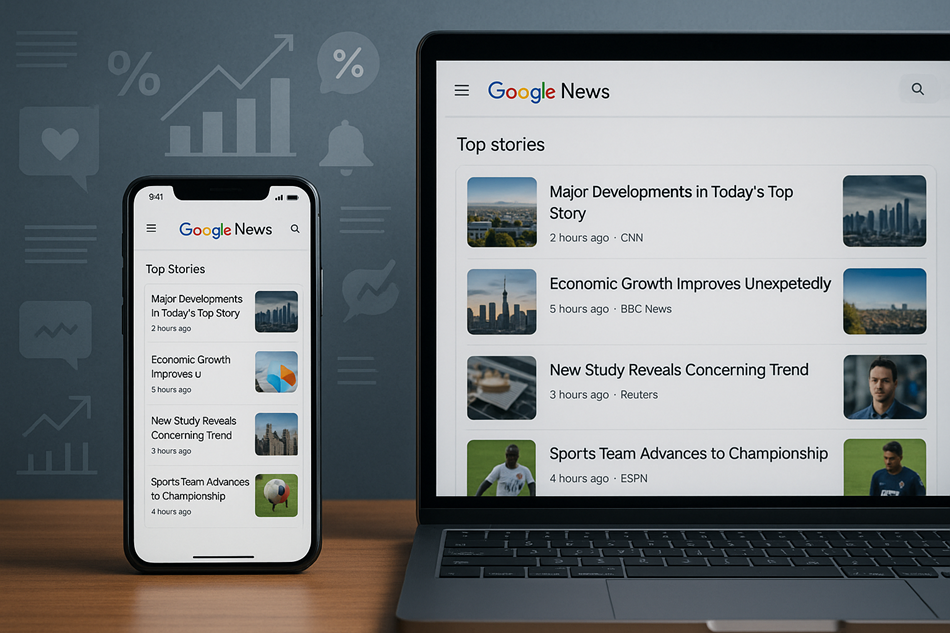Landing a spot in Google News can put your brand in front of millions of readers overnight.
For publishers, businesses, and thought leaders, it’s one of the most powerful ways to drive traffic, gain credibility, and establish authority.
Unlike traditional search results, Google News highlights timely and trustworthy content, giving you instant visibility when it matters most.
But getting featured isn’t automatic. Google has strict eligibility guidelines, technical requirements, and editorial standards that every site must meet.
The good news is that with the right strategy, you can position your content for inclusion and dramatically increase your chances of being picked up.
Let’s break down exactly how to do it.
Key Takeaways
- Google News matters because it boosts credibility, authority, and audience reach.
- Eligibility depends on meeting Google’s content and technical standards, including E-A-T (Expertise, Authoritativeness, Trustworthiness).
- Strong site structure with fast load times, clean navigation, and schema markup is essential.
- Content must be newsworthy, written in a clear, fact-based style, and published consistently.
- Publisher Center submission is required, including site verification and section setup.
- Beyond submission, backlinks, promotion, and multimedia strengthen visibility.
- Avoid common mistakes like thin content, clickbait, or overly promotional writing.
- Advanced strategies like creating a news section, partnering with PR experts, and optimizing for local coverage improve long-term success.
Why Getting Featured in Google News Matters
Getting into Google News is about more than visibility. It builds trust, brings in high-intent traffic, and opens doors for greater reach.
When your content is surfaced by Google News, it signals both quality and credibility to your audience and to other publishers.
A signal of authority and trust
Google News doesn’t feature just any website. Its inclusion standards mean your articles are vetted for reliability, originality, and compliance with strict content guidelines.
This adds a layer of trust that traditional search rankings alone don’t provide.
A surge in targeted traffic
Unlike evergreen search results that grow slowly, Google News thrives on freshness.
A relevant story can attract a sudden wave of visitors within hours of publishing. This gives your content a unique opportunity to reach audiences while the topic is still hot.
A gateway to wider exposure
Journalists, bloggers, and industry leaders often use Google News to find sources and reference material.
If your article is featured, it can get cited, linked, and shared beyond the platform itself.
That kind of organic amplification strengthens both your SEO and your brand presence.
Understanding How Google News Works
Before you can position your site for inclusion, it’s important to understand how Google News functions.
It’s not the same as a typical search result.
Instead, Google uses a mix of algorithms and strict editorial standards to surface timely, relevant, and trustworthy articles.
What Google News Really Is
Google News is a news aggregator that collects stories from thousands of publishers worldwide. It prioritizes timeliness, authority, and accuracy over traditional SEO signals.
This makes it different from Google Search, where evergreen articles can rank for months or even years.
Algorithmic Selection vs. Manual Curation
Most of Google News is powered by algorithms, which evaluate signals like site credibility, content freshness, and topical relevance.
However, human editors also review content to ensure accuracy and compliance with content policies. Both layers work together to filter what users see.
Common Misconceptions About Google News
One of the biggest myths is that Google News only features major outlets.
In reality, smaller publishers, niche blogs, and local news sites are regularly included—if they meet the standards.
Another misconception is that you can “SEO-hack” your way in. While optimization helps, editorial quality is the deciding factor.
Eligibility and Content Guidelines You Must Meet
Not every website can appear in Google News. Google sets clear standards to ensure readers only see reliable, relevant, and high-quality content.
Meeting these requirements is the first step before even thinking about submission.
Google News Content Policies
Google expects publishers to follow strict editorial rules.
Content must be original, fact-based, and written in a clear, journalistic style.
Articles that are overly promotional, misleading, or thin on substance are often excluded.
Sites must also avoid inappropriate content, spammy practices, and clickbait headlines.
Technical Requirements for Inclusion
Behind strong content is a technically sound website.
Google News favors sites that are easy to crawl, load quickly on both desktop and mobile, and maintain clean, organized navigation.
Structured URLs, accessible categories, and a reliable hosting setup all contribute to meeting the standard.
The Role of E-A-T (Expertise, Authoritativeness, Trustworthiness)
Google applies the E-A-T principle heavily in news.
This means your content should demonstrate subject matter expertise, cite credible sources, and be tied to authors who can be identified and trusted.
Author bios, clear publication dates, and transparency about your organization strengthen your chances of acceptance.
Building a Google-News-Ready Website
Even the best article won’t make it into Google News if your site isn’t technically sound.
A news-ready website is fast, organized, and easy for both readers and search engines to navigate. The technical foundation sets the stage for every piece of content you publish.
Site Structure and Technical Setup
Google favors websites that are well-structured and simple to crawl. This means using clear categories, logical navigation, and a sitemap that’s regularly updated.
Speed is also critical—slow-loading pages reduce user experience and lower your chances of being indexed. Your site should also be fully responsive, adapting smoothly to mobile devices where most readers access the news.
Schema and Metadata
Technical signals like schema markup give Google more context about your content.
The NewsArticle schema, for example, helps identify an article’s headline, publication date, and author. Metadata such as titles and descriptions should be concise, descriptive, and aligned with journalistic standards.
Don’t forget the basics: visible publishing dates, clear bylines, and secure HTTPS connections are all trust signals Google looks for.
Crafting Newsworthy Content That Gets Picked Up

Technical readiness is only half the battle. To earn a place in Google News, your articles must deliver genuine news value.
That means producing content that is timely, relevant, and written in a way that aligns with journalistic expectations.
What Counts as “Newsworthy”
Google News prioritizes stories that matter now. Articles tied to current events, industry developments, or fresh insights stand a stronger chance of being included.
Opinion pieces and evergreen guides can add depth, but the backbone of a news-ready site is timely coverage that adds something new to the conversation.
Writing Style That Fits Google News
Readers in Google News are looking for clarity, not fluff. Headlines should be direct, keyword-rich, and immediately tell the reader what the story is about.
The article itself should follow an inverted pyramid style—putting the most important facts first, then layering in supporting details.
A neutral, fact-based tone is key. Overly promotional or subjective writing often keeps sites out.
Frequency and Consistency
Publishing cadence signals to Google that you are a reliable source of updates.
Consistency matters as much as frequency. A site that publishes thoughtful, timely stories on a regular basis is more attractive than one that posts sporadically in bursts.
Steady output shows you’re committed to being a dependable voice in your space.
Step-by-Step: Submitting to Google News Publisher Center
Once your site is ready, the next step is to submit it through the Google News Publisher Center.
This platform is where publishers officially register their publication and provide details that help Google understand their content.
Create a Publisher Center Account
Start by signing into the Google News Publisher Center with your Google account.
You’ll need to provide basic information such as your publication name, website URL, and location.
Accuracy here matters, as this information is used across Google News.
Add and Verify Your Site
Google requires you to verify that you own the domain you’re submitting.
This is typically done through Google Search Console by adding a DNS record or uploading a verification file.
Verification ensures that only site owners or authorized representatives can submit a publication.
Set Up Categories and Sections
Within Publisher Center, you can organize your content into categories and sections—such as Business, Technology, or Lifestyle.
This helps Google understand the structure of your site and ensures your stories are served to the right audiences.
Adding RSS feeds or specific URLs makes your updates easier for Google to pick up.
Submit for Review
Once everything is configured, submit your publication for review.
The approval process can take a few weeks. During this time, Google checks both technical compliance and content quality.
If approved, your site becomes eligible to appear in Google News and related surfaces across the platform.
Optimizing Beyond Submission
Getting into Publisher Center is only the start.
To consistently show up in Google News and maximize your reach, you need to keep improving your visibility signals.
This means going beyond the basics and actively promoting your content.
Build Authoritative Backlinks
Google News rewards authority. Earning backlinks from reputable sites signals that your content is trustworthy and relevant.
Focus on building relationships with industry publications, guest posting, and getting cited by credible outlets.
Even a few quality backlinks can improve how Google views your site.
Promote Early to Drive Signals
News content performs best when it gains traction quickly.
Share articles across your social media channels, send them to your email list, and encourage engagement.
Early clicks, shares, and mentions signal relevance, which can boost your article’s visibility inside Google News.
Use Multimedia to Enrich Content
Articles with images, videos, or infographics often perform better.
Visuals not only capture reader attention but also provide additional context for Google.
Be sure to use descriptive alt text and proper captions, as these details help with indexing.
Monitor Performance Regularly
Tools like Google Search Console and the Publisher Center dashboard give you insight into how your articles perform.
Track impressions, clicks, and coverage trends to see what’s working.
This feedback loop helps you refine your content strategy and double down on what drives results.
Common Mistakes That Keep Sites Out of Google News
Even well-intentioned publishers can stumble when trying to get featured in Google News.
Understanding the most frequent mistakes helps you avoid setbacks and improve your chances of approval.
Thin or Duplicate Content
Google News is selective about what it surfaces. Articles that repeat information from other sources without adding unique value often get ignored.
Similarly, short posts with little depth are unlikely to qualify. Every article should bring fresh insights or original reporting.
Excessive Opinion or Promotional Tone
While analysis has its place, Google News prioritizes fact-driven reporting.
Overly opinionated articles, sponsored-style copy, or self-promotion signals to Google that your site functions more like a marketing blog than a news source.
Keeping your writing neutral and evidence-based makes it far more newsworthy.
Poor Site Structure and User Experience
A cluttered site filled with pop-ups, broken links, or confusing navigation frustrates both readers and crawlers.
If Google struggles to index your pages—or if readers quickly bounce—your chances of inclusion drop significantly.
A smooth user experience is just as important as solid reporting.
Violating Content Policies
Sites that publish misleading headlines, use clickbait tactics, or push inappropriate content risk rejection.
Google applies strict guidelines to maintain reader trust, and even a few violations can hurt your eligibility.
Always prioritize accuracy and clarity in your headlines and articles.
Advanced Tips to Boost Your Chances

Once the basics are in place, you can take additional steps to strengthen your visibility in Google News.
These approaches help set your publication apart and improve long-term performance.
Create a Dedicated News Section
Having a clearly labeled “News” section on your site signals to Google that you regularly publish timely updates.
This also makes it easier for crawlers and readers to find your most relevant stories.
Organizing content by topic—such as business, tech, or lifestyle—adds clarity and structure.
Collab With PR Partners
Strategic PR partnerships can amplify your reach.
Agencies like Trelexa help position stories for greater visibility, making it more likely that your content gets picked up by both Google News and external publications.
This mix of technical compliance and media exposure is a powerful combination.
Use AI Tools Without Sacrificing Quality
AI can support speed and consistency, but it can’t replace journalistic standards.
Use it for tasks like drafting outlines, generating headlines, or analyzing trending topics—but always pair the output with human editing.
Original reporting, fact-checking, and context remain non-negotiable.
Optimize for Local Coverage
If you operate in a specific region, don’t overlook the power of local news.
Google News gives visibility to stories tied to geography, making it easier for local businesses and publishers to reach highly engaged audiences.
Adding location-specific keywords and context strengthens your relevance.
Final Thoughts
Getting featured in Google News is the result of preparation, consistency, and meeting the standards Google sets for trusted publishers.
From technical setup to editorial quality, every detail plays a role in determining whether your content gets picked up or passed over.
Trelexa helps publishers and businesses bridge the gap between strong content and strategic exposure.
If your goal is to see your stories featured where readers are already looking for news, we’ll guide you through every step of the process.

